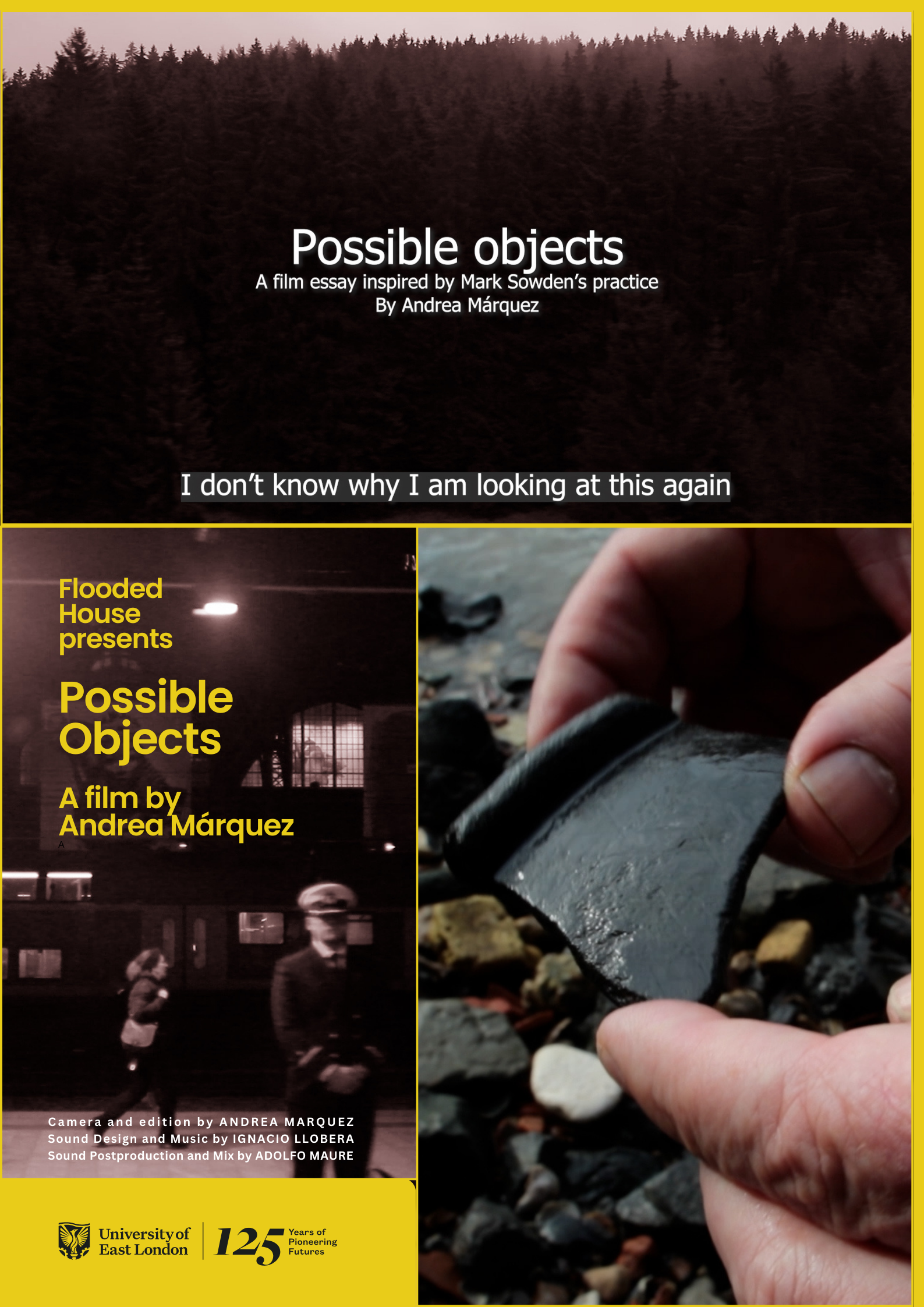
Texts by Mark Sowden
Two journeys through two very different landscapes; the Thames foreshore and the railway network of Germany. Two travellers who are searching but don’t know what they will find. They stay open and attentive to the landscapes they travel through and the objects they encounter, hoping that meaning and form will emerge in time.
A satellite map made 3D by digital algorithms. Colour drained. The sepia tone making it difficult to determine time and place. An unseen operator navigates the map, jerky movements are evidence of a mouse moved by hand. We see a river cutting through a city, the liminal space of the foreshore and strange structures in the middle of a river.
This opening scene of the film Possible objects introduces themes of travel, navigation and encounter with objects that are beyond immediate understanding, themes that resonate through the film.
We leave the space of the digital map and begin another journey as we follow Mark Sowden through the streets of London to his destination; the intertidal zone of the Thames foreshore. The camera follows Mark as he searches for material evidence of London’s past. The things he finds are on the verge of loosing their object identity. They are broken things that need Mark’s attention to be recognised, valued and understood.
As Mark walks towards the river, searches the foreshore and later sorts and shows his finds he talks to Andrea Marquez, trying to articulate the motivations and meanings of his practice. Themes emerge; searching without knowing what will be found, travelling through a landscape with an attentive mind and an interest in ambiguous objects that excite curiosity.
It is these themes that inform a reading of another journey. Cut into the film is footage of a train journey taken by Andrea Marquez across Germany in 2015. Andrea had embarked on a 5 day journey following self imposed rules of living on trains night and day and never leaving the stations. There was no destination, only continual travel. She filmed what was visible outside the window. The footage had lain unedited for seven years but gradually, as Andrea witnessed the journeys Mark took, she began to research and recognise something in her own journey. The viewer is left to consider what we find when we search with a passive, receptive mind.
The title Possible Objects is taken from the title of Mark’s Doctorate show in 2015, coincidently the same year as Andrea’s rail journey. In this year Mark wrote:
Objects are usually associated with fixed points of understanding. Indeed all those things that are recognised, categorised and used can be thought of as objects. In contrast, Possible Objects exist in a state of immanence, waiting to be realised, hovering on the cusp of legibility. The Possible Object is ambiguous and elusive, slipping out of place. It exists in the future as a promise, an object of desire just out of reach. It exists in the present as a question, something that has not yet been categorised or understood.
This film is full of possible objects from the structures made strange by digital mapping to the broken fragments of pottery found on the Thames and the footage of a train journey without a destination.
Director, Cinematographer, Producer & Editor:
Andrea Márquez
Artistic Advisor & Protagonist:
Mark Sowden
I was born in London, spent an early childhood in Australia and then returned to London for my secondary schooling. In the 1984 I completed a B.A. in Fine Art at North East London Polytechnic and in 1985, gained a Masters Degree from Manchester Polytechnic. I have worked as a sculpture technician at University of East London since 1990 managing a casting, ceramic and metal workshop. This workshop is largely analogue but over the last decade I have worked with colleagues to develop hybrid ways of making that combine digital and analogue processes.
In 2014 I completed a Professional Doctorate at University of East London presenting a body of photographic work under the title ‘ Possible Object’.
I have shown with a group of artists called Ground Collective on four occasions between 2015 and 2023, opened my studio regularly for the E17 Art Trail and had one solo exhibition at the Walthamstow Village Window Gallery in 2017.
Mark Sowden’s statement
Always searching. Sometimes finding. Occasionally making, sense of something.
I search the landscapes I travel through looking for those things that feed my curiosity and demand my attention. These are things that are not immediately comprehensible, things that are on the verge of loosing or gaining an object identity. I process my finds in many different ways, drawing, photographing and sculpting to give them my attention, to bring them into view, and to give them a new place in the world. My passion for searching the Thames foreshore for material evidence of London’s past has deepened over the last seven years leading to new ways of processing and presenting finds outside of a Fine Art context. I have shown my finds alongside other mudlarks at Southwark Cathedral and the Roman Ampitheatre under the Guildhall Art Gallery London.
Sound Designer & Music:
Ignacio Llobera
Ignacio Llobera is a composer and sound artist based in Buenos Aires. With a background in violin and musicology he is oriented towards creating works that explore the interplay between music, scene, representation, landscape and narrative. His compositions involve new opera, chamber music, experimental and acousmatic pieces for dance, films and installations. Additionally he collaborates creating sound designs and real-time electronics for other artists.
Sound Post Production and Mix:
Adolfo Maure
Adolfo Maure Giacchetti is a sound designer, re-recording mixer and sound supervisor based in Los Angeles, CA. He has collaborated in many TV series, films and animation projects.